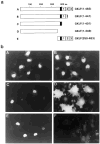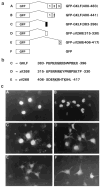Two potent nuclear localization signals in the gut-enriched Krüppel-like factor define a subfamily of closely related Krüppel proteins
- PMID: 9218496
- PMCID: PMC2268085
- DOI: 10.1074/jbc.272.29.18504
Two potent nuclear localization signals in the gut-enriched Krüppel-like factor define a subfamily of closely related Krüppel proteins
Abstract
The gut-enriched Krüppel-like factor (GKLF) is a newly identified transcription factor that contains three C2H2 Krüppel-type zinc fingers. Previous immunocytochemical studies indicate that GKLF is exclusively localized to the nucleus. To identify the nuclear localization signal (NLS) within GKLF, cDNA constructs with various deletions in the coding region of GKLF were generated and analyzed by indirect immunofluorescence in transfected COS-1 cells. In addition, constructs fusing regions representing putative NLSs of GKLF to green fluorescent protein (GFP) were generated and examined by fluorescence microscopy in similarly transfected cells. The results indicate that GKLF contains two potent, independent NLSs: one within the zinc fingers and the other in a cluster of basic amino acids (called 5' basic region) immediately preceding the first zinc finger. In comparison, putative NLSs within the zinc fingers and the 5' basic region of a related Krüppel protein, zif268/Egr-1, are relatively less efficient in their ability to translocate GFP into the nucleus. A search in the protein sequence data base revealed that despite the existence of numerous Krüppel proteins, only two, the lung Krüppel-like factor (LKLF) and the erythroid Krüppel-like factor (EKLF), exhibit similar NLSs to those of GKLF. These findings indicate that GKLF, LKLF, and EKLF are members of a subfamily of closely related Krüppel proteins.
Figures



References
Publication types
MeSH terms
Substances
Associated data
- Actions
Grants and funding
LinkOut - more resources
Full Text Sources
Other Literature Sources
Molecular Biology Databases

